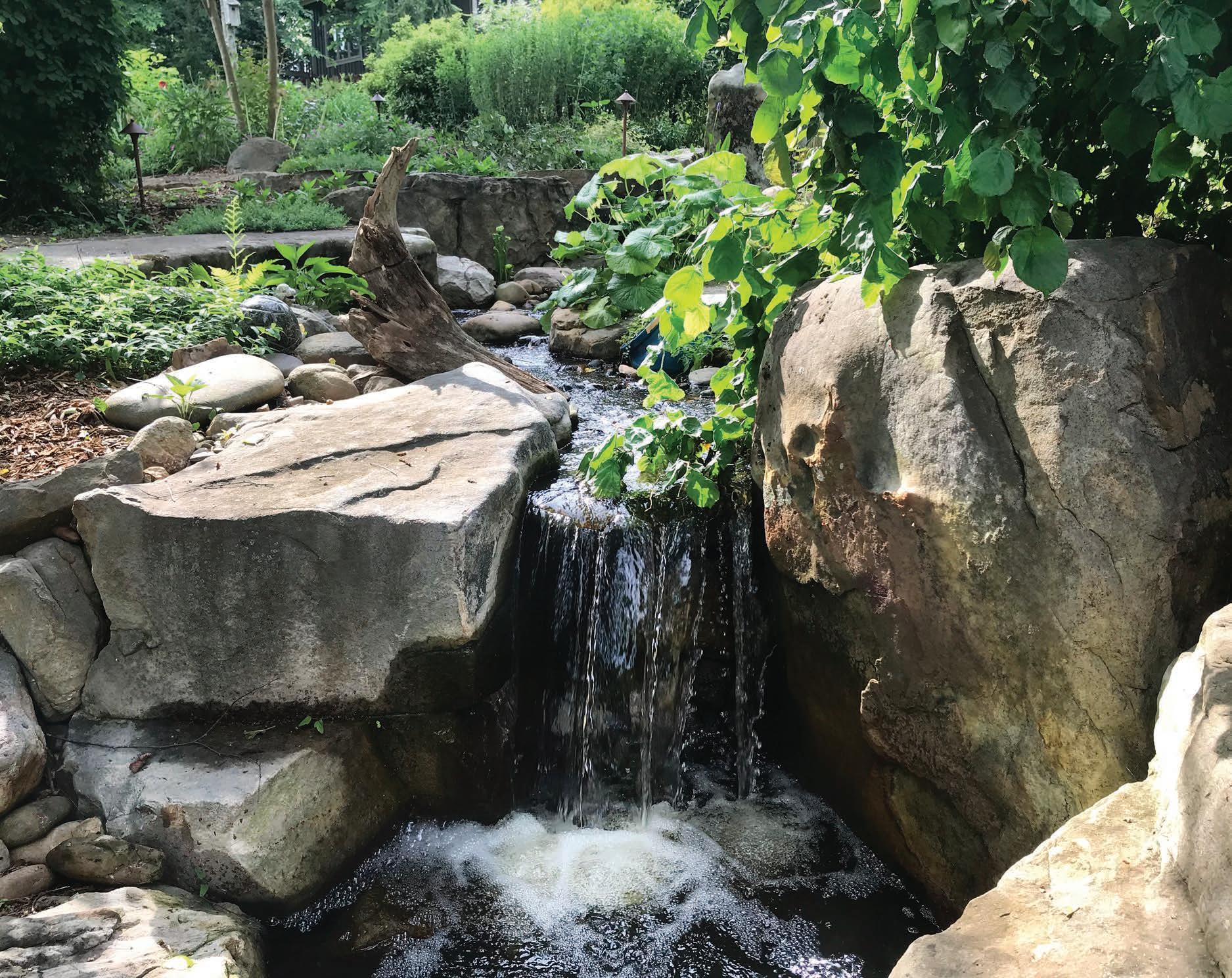
7 minute read
The Problem is Ammonia
Ensuring Balance
A fully-stocked pond can still have both healthy fish and good water quality.
Advertisement
The problem is
Striving for balance in an aquatic ecosystem
by Carolyn Weise, Ecological Laboratories, Inc.
No two ponds are alike. However, the common biological processes within every pond’s ecosystem are essential and must be carefully monitored and maintained. No matter what type of construction or filtration you select, a successful, healthy ecosystem will depend on the level of pond management, the fish load, the amount of food added and the extent that the aquatic ecosystem’s biological food web can support marine life .
The first step to achievement of good water quality is understanding certain essential biological processes. The second step is taking the necessary actions to correct issues that may contribute to chemical imbalances in your pond — especially an
This small goldfish pond (left) includes gambusia. These two species are capable of overwhelming a system, given one pump and no modern filtration. The food web participants are doing all the work. Just smell the ammonia in the bottle (middle) — do you want your fish swimming in that? Everything is thriving in this beautifully balanced pond (right), even though a light covering of algae is visible on the bottom.
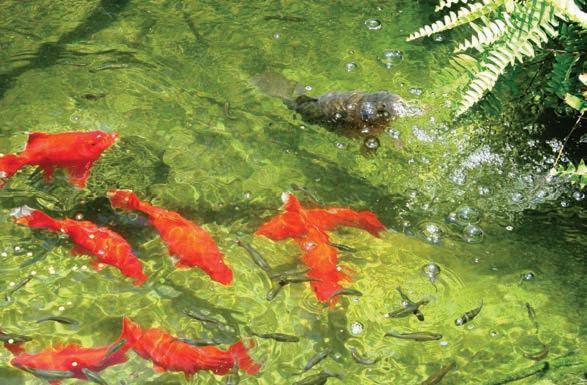
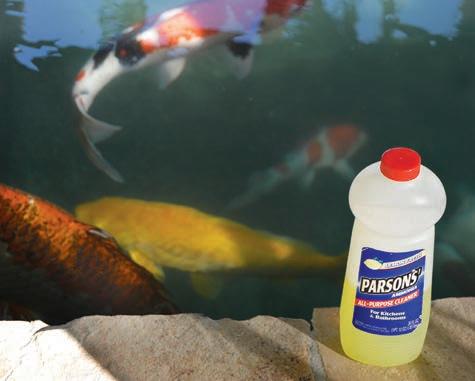

overload of ammonia.
Where Does it Come From?
Most ammonia is generated from the biological breakdown of fish food, which contains nitrogen-bearing materials that are biologically converted to amino acids, and then to ammonia. Thus, whether it goes through the fish or lays uneaten on the bottom of the pond, excess fish food is a huge generator of ammonia. Ammonification is the process of ammonia production. The removal process is called nitrification.
Microbes called consumers oxidize (or remove) organic waste matter produced by excessive fish food and marine life within the ecosystem. Then, there are very important microorganisms called nitrifiers that are responsible for the reduction of ammonia that is generated within this biological process. Ammonia is converted to nitrite and then to nitrate. These are key, essential members of the food web inventory.
These ammonia-oxidizing species are not the same as the microbes that oxidize organic waste produced by excessive fish food and marine life. And, while these microbes are not in the published food web, many forms of life in the marine web will not survive without the support of certain cultures and elements in the environment to stabilize them. This is certainly a missing link — or building block — that assures the ongoing health of the ecosystem, with or without the extraneous bells and whistles.
Let’s say the aquatic ecosystem in your customer’s pond has two important essential biological processes taking place 24 hours a day to maintain the health of the environment. First, there’s the biological removal of the organic waste matter that results from heterotrophs and the nutrients provided to support them within the ecosystem. In this process, the organic waste is biologically reduced, with the waste matter converted all the way to carbon dioxide, water and ammonia. Second, aerobic autotrophs remove ammonia from the water, making it safe for your fish and other marine life. This can only be done by your nitrifying bacteria.
The Algae Connection
According to Karl Blankenship, the editor of the Bay Journal, while plants like nitrates, algae actually prefer ammonia. Algae prevention is in direct correlation with ammonia reduction. “Algae have to convert nitrate … into ammonium before they can use it,” Blankenship said. “When ammonia hits in the water, it is ready to use. Algae do not have to spend any energy to convert it, so more of the nutrient is used for growth.”
That’s right. Simply put, ammonia has the capability to spur more algae growth than nitrate can. When there is more algae than the organisms can consume, one-celled plants like plankton can die. Algae can also cloud the water, blocking light from reaching the underwater plants that play essential roles in balancing the ecosystem.
Dr. Hans Paerl, a researcher at the University of North Carolina’s Institute of Marine Sciences, said that an overabundance of any kind of nitrogen will probably enhance algae growth. “But it may turn out, depending on what the nitrogen source is, that (growth) may be expressed in different kinds of algae,” he added.
Dr. Paerl also stated that historically, rain would have carried little nitrate or ammonia, causing almost all the nitrogen to wash out of the rivers. However, atmospheric deposition bypasses that route, directly delivering nutrients (including ammonia) to nitrogen-starved algae populations. Studies show that a large nitrogen pulse delivered during a storm can be consumed within a matter of hours, leading to the all-too-familiar algae blooms that pop up after heavy rains.
How to Manage it
While almost everyone understands am monia and its potential toxicity, ammonia management is where most pond problems occur. This is related to achieving and maintaining nitrification, the biological process for ammonia removal. We like to call it “cycling the pond.”
Keep in mind that this biological process is a completely separate bioprocess from the biological waste-removal process, and it is carried out by a separate group of microorganisms that have different support requirements. These are essential to the process, because without them, nitrification will stop, ammonia levels will spike,
and fish mortality will occur.
For the sake of simplicity, remember that two groups of autotrophic bacteria are responsible for ammonia removal: Nitrosomonas, which oxidize ammonia into nitrites, and then Nitrobacter, which oxidize ammonia into less-harmful nitrates. The end process may generate some visible effects of algae and plant growth in the pond, since plants utilize nitrates in the process of photosynthesis.
In ammonia oxidation, carbonate hardness, or KH, is one of your tools. In order to achieve and maintain a healthy “cycle” in the pond, assure a safe level of KH, which is perhaps the most overlooked and yet vitally important parameter of the pond. If the KH drops below 80 ppm, a new cycle is set in motion — a downhill slide. Nitrobacter are unable to oxidize nitrites, so the nitrite levels will rapidly build to toxic levels and cease nitrate production.
As a rule, a pond requires 7.1 ppm KH to remove 1 ppm ammonia. Sources of ammonia in the pond include fish exhalation, organic waste reduction, uneaten food, dead insects and dying vegetation, and dirty filters and skimmers. A continual buildup of ammonia would rapidly become toxic, and it becomes even more toxic at higher temperatures and higher PH. Ammonia actually exists in water in two forms, NH3 and NH4+. The NH3 form is called free ammonia and is toxic to fish, while NH4+, or ammonium salts, is not. Ammonia below a pH of 7.6 will be in the non-toxic NH4+ form, while it will take the toxic N3 form above a pH of 7.8.

Heavily stocked ponds will naturally utilize more KH during nitrification on ongoing basis, putting their cycle at risk. Water changes can replenish depleted KH if the correct parameters are monitored. Check your tap water to make sure the incoming water has sufficient KH to replenish the pond. KH will buffer and stabilize the pH, preventing pH crashes.
Respect the Little Guys
It is important to share your knowledge of the real facts with your clients. Let them know how a pond works and why they need to respect the “little guys” at the very bottom of the food web who are constantly doing their jobs (if we allow them, of course). Without algae, there is no pond, and there are no fish. When you build a beautiful, state-of-the-art pond and walk away, your client will need to care for it.
Adding koi to the ecosystem increases the organic waste matter, feeding all the microbes, especially those that chemically oxidize ammonia and nitrite. The goal is to achieve a balance between the producers (koi) and the consumers (nitrifiers) to ensure a successful pond . a
Carolyn
Weise is the customer relations manager for Ecological Laboratories, Inc. She studied ornamental horticulture at the State University of New York at Farmingdale. She moved to Florida in 2006 to work at the Cape Coral campus of Ecological Laboratories. Today, Carolyn serves as a liaison to koi clubs and recently joined the master gardener’s program in Lee County. She has no plans to ever retire, because she loves her work. For additional information on pond management, nitrification and denitrification, contact her at Carolyn.Weise@ecologicallabs.com.
About the Author
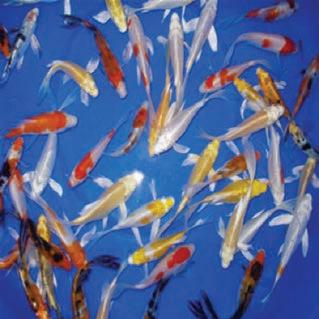
Healthiest Koi and Goldfish in the USA!
● 100% Ulcer Free Farm ● 100% Virus Free Farm ● No New Fish Introduced in 17 years
100% Satisfaction Guarantee
Rated Best All Around American Koi by International Koi Judge
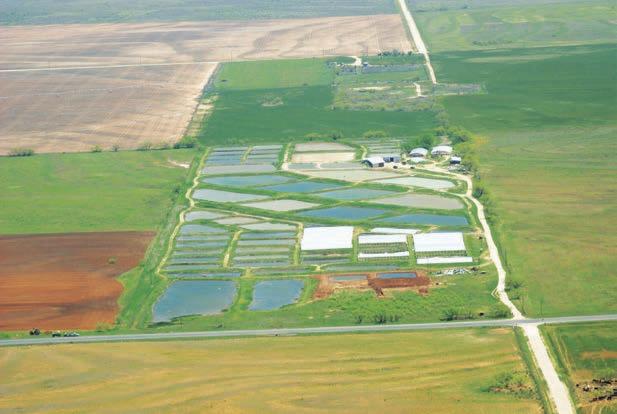
● Brilliant Colors ● Stunning Patterns ● Great Selection of Different Koi
and Butterfly Koi
One of two locations
www.BassingerKoiFarm.com
Visit our new website at:
New Customer Special! (on first $500 order) 50% off
